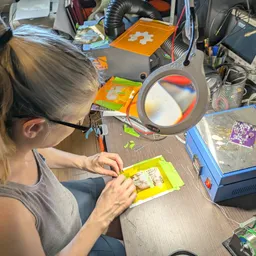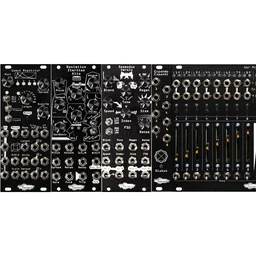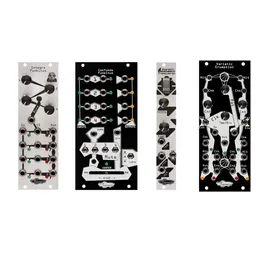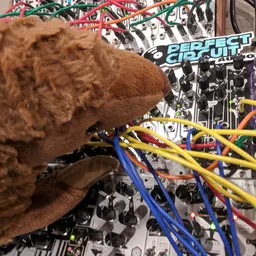This week, Shawn, our Audio Alchemist, reflects on his work using modular synths in the context of sound design.
What is sound design?
Sound Design is the art of creating sounds for television shows, films, and video games, as well as other forms of entertainment. For live action productions, the audio recorded on-site, known as production sound, is often recreated later by sound designers for more pristine audio. This regularly includes the re-recording of an actor's dialog lines in a studio (a process known as ADR, which stands for Automated Dialog Replacement). All of this is done to better isolate the desired sounds and eliminate set noise and unwanted environmental sounds from the location, as well as to have more control over the final mix levels of the various elements.
This means that sound designers often have to use audio library recordings of real-world sounds, or record real physical sounds on their own to get what they need. With animations and video games, this is especially true, since there is no production sound and all the sounds need to be provided by the sound designer(s). Sounds of real physical objects help sell that the animated visuals represent “real” things, and gives them weight. However, there are many opportunities where realistic sounds can be created using completely unexpected sources, even for live action. Perhaps you've heard of recording celery being snapped in half to make the sound of a bone being broken, or the old radio trick of wobbling a large piece of aluminum to create thunder sounds. To give a personal example of an unexpected source, I was once tasked with making sound for a rocket taking off, specifically that air-ripping sound heard as the rocket ascends through the air. Our library had no decent recordings of this sound, so I put a contact mic on a textured plastic briefcase and slowly dragged my fingernails across it. When paired with the visual (and with a little help from EQ) it was completely convincing. There was even a subtle phase-shifting effect as my nails got closer to the contact mic adding to the realism.
Using modular synthesis for sound design
There are often times when using a modular synth for these tasks can be very practical. There are no right or wrong source sounds if the end result is what you are after, and I've worked with some amazing sound designers who create sounds exclusively by blending, editing, and manipulating library source sounds. But I personally have found modular to be a great resource in specific situations. Here are a few examples that I've used for video game work:
I needed the sound of heavy wind outside coming in through the cracks of a closed door. As often can happen, the sound libraries we had licensed did not have anything that felt right, or didn't have tree branches snapping and other unwanted elements. I patched up a Synthesis Technology E-340, and made heavy use of the Chaos and Spread parameters modulated by a Make Noise Wogglebug. After honing some of the settings and adding some subtle reverb, I was able to get a fantastic, creepy, and realistic wind sound that worked great for that part of the game environment.
In another game, we needed a cockpit alert sound. I went online and found some real-world examples from military jet videos. The audio quality was dubious in the videos, and of course you can’t just take recordings from the internet to use in a commercial product, so I only used that as a reference. I was able to quickly patch up a nearly identical version of the sound (a short rising pitch that ramped up twice in a row) using a simple oscillator, a VCA, and a couple envelope generators.
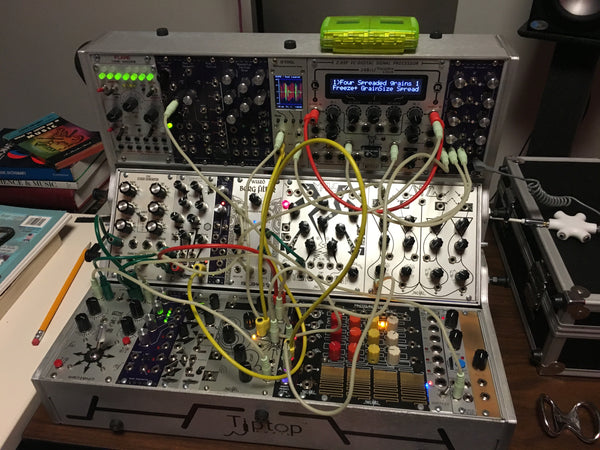
Another day at the office
Modular synths can really shine if you are working on a project that is set in a science fiction environment.
There was a scene in a video game where I needed to make a futuristic elevator sound in an expensive offshore resort. It had to match the timing of the scene and we had a lot of work to finish in a short amount of time. Since I was familiar with my modular system, it was much faster for me to just patch up a sound than try to create it in software. And it was more fun, to be honest. I patched together a soft drone sound, once again using the E-340, and used the X and Y CV from a joystick module to manipulate the VCO pitch and VCA simultaneously. I played the sound along with the scene and had it recorded and in game very quickly.
Happy accidents are a welcomed occurrence in sound design and can provide source sounds when you least expect it. Once Stephen had loaned me a prototype module that was a precursor to the Noise Engineering Pura Ruina distortion. I had plugged a guitar into it and before actually trying out what I'd set out to do, I bumped and rubbed my jacket sleeve against the strings. The sound was amazing. It sounded like a futuristic electrical impact with an almost ricochet sound trailing after. I recorded several different takes of this and ended up using them as layers for many different impact sounds for things like energy shields and futuristic weapons.
Sound designers almost always end up blending several source sounds together to create unique new sounds. A common technique for getting interesting yet 'grounded' sounds is to blend electronic and physical sounds together. Often I would blend a sound from the modular with a physical button push or switch flip to have the physicality as well as the futuristic feel.
As modular users know, the possibilities are endless, and with even a basic knowledge of modular patching and a few select modules, a vast array of unique sounds are possible. Modular is a great way to create unique custom sounds you know aren't being used by other sound designers.
Happy patching!
